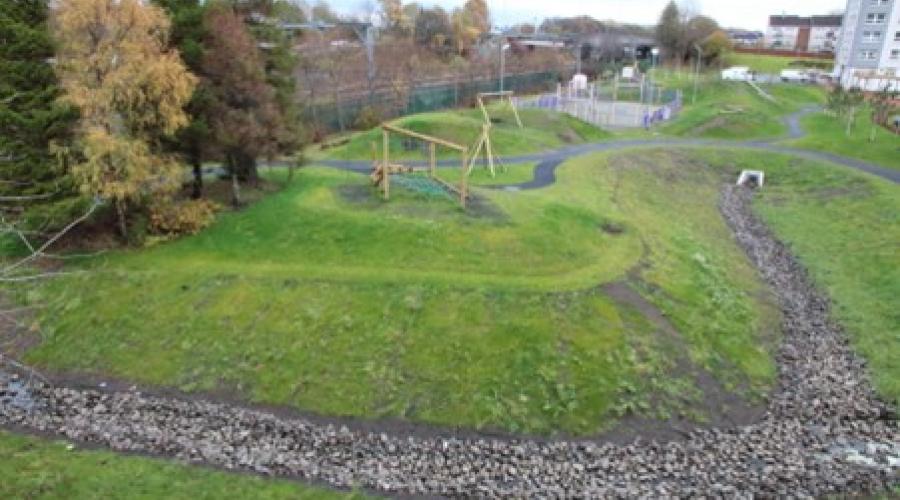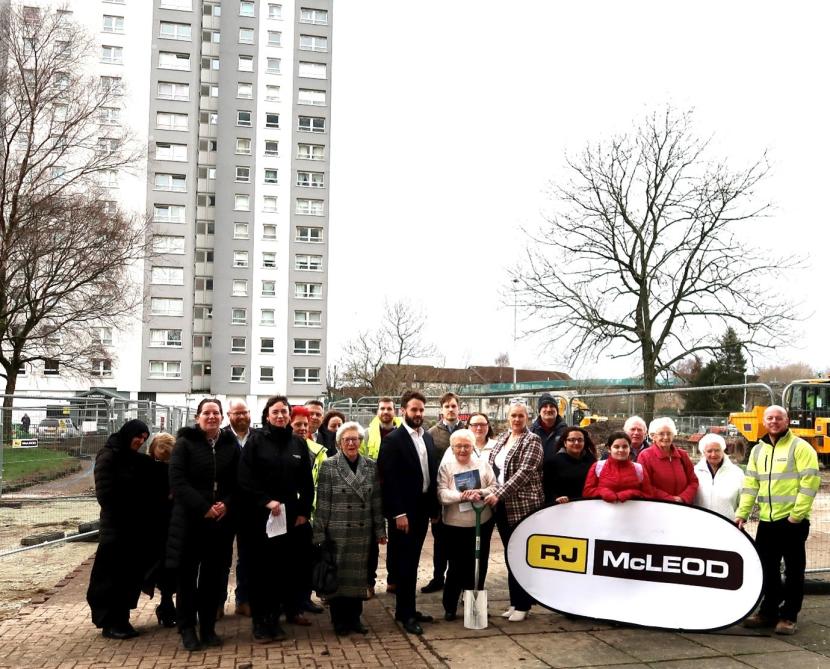
Queensland Gardens Community Park
Incorporating surface water management in a neighbourhood scale green infrastructure asset
Queensland Gardens Community Park
Grantee: Southside Housing Association
What the project set out to achieve
The project was a partnership between Southside Housing Association (SHA) and Glasgow City Council (GCC). The aim was to create a new green infrastructure neighbourhood asset: Queensland Community Park, within the Cardonald area. It manages manage flood risk for the wider Cardonald and Hillington catchment and enhances previously underused open space through the creation of adventure/natural play facilities, tree and shrub planting, and improved parking and access to the site.
Where the project idea came from
The surface water management elements of the project were initiated through the Surface Water Management Plans (SWMPs) across Glasgow. The plans were formed by Glasgow CC in line with the Metropolitan Glasgow Strategic Drainage Partnership’s (MGSDP) vision to transform how the city manages rainfall to end uncontrolled flooding and improve water quality. Computer simulations showed that the site was the most effective location to install surface water measures to benefit the wider area.
In addition to this SHA who have two multi-storey housing blocks on the site identified the site as having limited amenity benefit and on-going parking issues due to poor design, and various incremental changes having taken place over a number of years; reducing the flow of access throughout the site and offering limited benefits to residents.

How the community helped develop the project
Green Action Trust chose the area as a pilot for their 10,000 Raingardens for Scotland project (which was run as a standalone project, separately funded through the Green Infrastructure Community Engagement Fund), seeing it as an opportunity to trial new ideas and complement other improvements to the area.
A series of community engagement sessions were held over 18 months before application to the GI Fund, with the intention to continue the engagement over following years. These have focussed on involving the community in generating ideas, through to getting their views on the proposed plans and the neighbourhood more generally.
How the project fits into the bigger picture
The project sits as part of the MGSDP and is a significant area of focus within GCC’s flood prevention priorities. It also fits well with the GCC City Development Plan and Glasgow and Clyde Valley Strategic Development Plan, with particular relevance to placemaking principles and spatial sustainability.
The project also supports GCC’s Open Space Strategy standards around quality, quantity and accessibility of available open space.
In the context of social housing this project delivers on the recommendations of those noted in ‘Maximising the benefits of green infrastructure in social housing’ McLintock, M. (2018), Scottish Natural Heritage Research Report No.1046
How the project improved the local area
The improvements positively manage surface water and the impact of climate change. It also creates spaces which improve biodiversity, are inviting, and encourage people to spend time in them, whether that be through play, going for a walk, spending time in fresh air or gardening. The improvements to parking also ensures vital access for emergency vehicles and refuse lorries and easier access for those with limited mobility.
An assessment of the Queensland Court/Gardens option provided a cost/benefit ratio of between 1.6 and 7.4, with a whole life present value benefit of up to £3.1 million.
An Economic Impact Assessment was carried out by engineering consultants SWECO (January 2018). This identified that the interventions noted in the Hillington/Cardonald SWMP has the potential to remove 14 residential properties from the 1 in 200-year+ climate change event.




